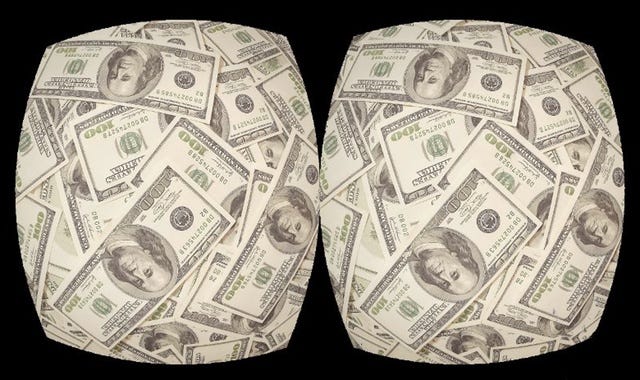Or, how we're down $36,000+ after making an HTC Vive launch title.
There’s been a little bit of talk recently about VR game funding, where money comes from, how much games cost and all that. Mostly this discussion comes up around money being received from companies like Oculus, and the exclusivity rights that may be a result of accepting the money. There’s been a lot of posts about how working in VR is expensive, and we developers need money to live. And since there isn’t a lot of money in VR right now, we have to go where the money is. I even wrote about the difficulties of VR game development a few months ago.
However, in all these posts by VR game developers, no ones really broken down the cost of making a VR game. Understandable, many people are bound to NDA’s and legally cannot reveal this information. Some people are worried about the backlash they might receive for talking about it, worried it might undermine various different things. Fortunately, I can talk about money and the cost of making a VR game, and so I will talk about the cost of making my companies first title, Light Repair Team #4.

This is not a VR game developer when they’re attacked for exclusivity.
This is not a VR game developer when they’re attacked for exclusivity.
A few things before we start
Before we break it down, I do need to provide a bit of background on the development of Light Repair Team #4 (hence forth known as LRT4). First off, I made the vast majority (like, 95%) of LRT4 over a 14 week period at the beginning of 2016, by myself. Programming, Art, Design. I had assistance from my good friend and co-founder of Eerie Bear Games, Noah Rojahn for tricky programming things (For the record, Noah has done and is doing MUCH, MUCH more post-launch. He’s also sole programmer on our new game). Also, John Dekker and Ed Harrison whipped up a couple music tracks to use for our trailer and game background music.
Secondly, the game was an HTC Vive Launch title. It was included in the press package that was sent out and was featured on the “Check out these VR games” page, featured on the main storefront for some time after launch. Beyond that, we were featured in a couple articles and only mentioned in couple more, mostly as part of the “here’s all the launch titles you can play now!” lists.
Thirdly, the game was self-funded, by me. That means that all costs of the game, and things related to the game were shouldered by me and my personal savings. I did charge myself for my own time. This means that I essentially was paying myself to work on the game. It sounds like a weird concept, but it’s absolutely essential in understanding and calculating the cost of a games development. You should always pay yourself or others, for the work you/they give or do for you.

Image Credit Metavariable
Image Credit Metavariable
The Actual Costs, the right and wrong ways.
I’m going to look at the cost break down two ways. First, we’re going to look at if I was paying myself my (somewhat low) hourly rate, as if I was a freelancer. I have learned that this is absolutely not a way you should budget your game. I’m going to include a break down of if I had, however, as a way to re-enforce the point I’m going to make.
Secondly, I’ll break down the cost of the game the “proper” way, as if I was pitching the game to Valve or Oculus for funding money. This is, as I understand it, the way that everyone has and should be pitching.
First, Hourly Rates (the wrong way, worth mentioning)
So, lets look at the break down of if I charged myself and Noah at my ridiculously low freelancers rate of 40 USD/hr (This is hella low. Please refer to the Gamasutra Salary Survey from 2014 for a more accurate value)
14 weeks of development x 40 hrs a week x $40.00 USD/Hr = $22,400 USD (This includes prototyping, design, art
5 hours of Noahs time x $40.00 USD/Hr = $200 USD
Cost of setting up the company + legal = $3,500 USD
Server Costs $10/mo x 3 months (We use Digital Ocean)= $30.00 USD
Cost of commissioning two music tracks = ~$3,000 USD
Total Cost? $29,130 USD
29k for a game that had about 70 minutes of content, using the inproper way of budgeting. Like I mentioned you shouldn’t budget your game like this. This method is harder to manage and keep track of as game development cycles can be highly unpredictable at an hourly level. It might take a month to do something, but how many hours in that month? Thats harder to tell. You shouldn’t look at game budgets like this. Something else to consider; even though a contractor is getting $40/hr, they’re really only getting at most 30/hr, because in the US self-employed freelancers taxes are at least 25% of their income. Don’t ever look at game development budgets like this. Ever.
Secondly, the “accepted” way to budget (The right way to start up)
Lets look at how people actually do it. Additionally, we’ll just assume that for the sake of arguing, Noah offered his 5 hours of time for free.
~4 months x $10,000 USD per dev* = $40,000 USD
Cost of setting up the company + legal = $3,500 USD
Server Costs $10/mo x 3 months = 30.00 USD
Cost of commissioning two music tracks = ~$3,000 USD
Total Cost? $46,530 USD
This is closer to a more realistic budget for the game.
*this value is a standard for many budget proposals, as it covers all necessary things (taxes, insurance) and adds a little bit of leeway.
But wait, there’s more!
Oops! I forgot some things! Like, creating and maintaining an office, since not everyone works from home (these are all rough estimates).
Average Cost of one VR ready workstation = $1,500 USD
Cost of Vive or Rift (if you don’t get dev kits) = $600–$800 USD.
Cost of office space rental (heavily location based) = $500–5,000 USD/mo






































